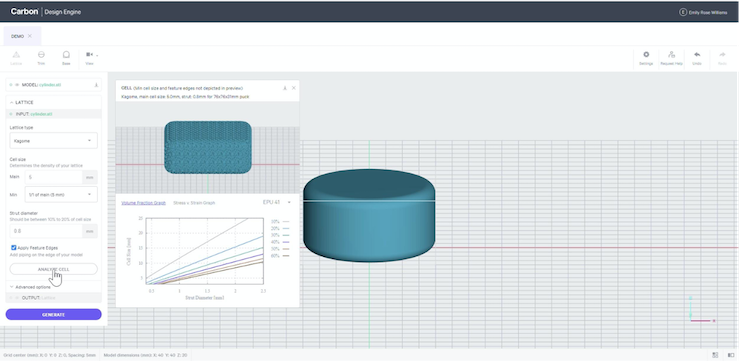On March 2, Carbon released its new Carbon Design Engine, with a lattice design generator that can automate the creation of conformal, single-zone lattices. Carbon has been working with its printing partners to help it develop conformal latticed products for years, but now their internal tool is available for public use.
A conformal lattice is one in which the “mesh” of the lattice is generated relative to the object’s shape and surface, rather than independently of it. In simple terms, the lattice design is shaped around the object, rather than being “pasted onto” the object.
“Designing with conformal lattices means no open joints or hanging nodes,” says Hardik Kabaria, Carbon’s Director of Software Engineering. “Hanging nodes can create a stress concentration fracture, so if you have them in your work, it’s not a good design.”
He also compared the texture of an object with open joints to “a bed of soft nails.”

A conformal lattice vs. a “regular”, uniform lattice. Conformal lattices lower the likelihood of stress fractures (Image via Nguyen, Park and Rosen/ International Journal of Precision Engineering and Manufacturing).
3D printing has made it easier to print with these optimized lattices, but many traditional CAD design programs don’t have the tool palette to support conformal lattice design. Many designers have to resort to manual intervention, or “gaming” their programs into making conformal lattices.
According to Carbon co-founder Phil DeSimone, they were inspired by their much-publicized partnership with Adidas to develop the Futurecraft 4D cushioning sole.
“Watching them go through that struggle with the design tools available was painful,” he says. “We wanted to create a tool that would help companies develop their products from beginning to end, and a lot of that is ideation, before anything gets printed.”
Carbon created the Carbon Design Engine (CDE), initially to collaborate on design projects with customers. The CDE is a cloud-based application capable of creating five different kinds of conformal lattices. It takes approximately 18 seconds to generate a conformal lattice for an object design, and can reduce both material use and print time by over 50 percent. It can also predict how the lattice will perform before it’s even generated, meaning faster iteration. CDE has been in beta since January, but as of March 2nd it’s available to anybody with a Carbon printer subscription.

The Carbon Design Engine is able to anticipate the performance of a lattice design before it is generated. In this instance, parameters are suggested to produce a model to lower the weight of the part. Image courtesy of Carbon.
The beta and the long period of internal use means that there have already been a significant number of use cases.
“All of the [Carbon] customers you’ve seen make lattices with Carbon, they’ve been using it,” DeSimone says.
Their press release points out one particularly timely use case: the design and creation of COVID-19 testing swabs. In March 2020, nasopharyngeal swabs became a hot commodity at the same time that disruptions in the supply chain made them hard to get. The Carbon team, lead by Kabaria, designed their first latticed swab in less than two hours. After that, the swab was prototyped, optimized, FDA-approved and in doctors’ hands within 20 days, an unheard-of timeline for most medical devices.

Nineteen iterations on the Resolution Medical latticed swab, as the team used the Carbon Design Engine to develop a design that was just as effective as a traditional nasal swab (Image via Carbon).
The release also mentions that their engine was used for Riddell’s Super Tacks X football helmet, and Specialized’s injury-reducing Specialized S-Works Power bike saddle. And while most of this work is is 3D printed using Carbon’s Digital Light Synthesis (DLS) technology, the team is excited to see where their tools could be used in other areas.
“Creating lightweight parts using metal could be more valuable even than our work in DLS,” DeSimone says. “For me, it’s about more than DLS. It’s about the industry as a whole.”
Ultimately, the team hopes that their tool will make it faster and easier to design for 3D printing, and increase the number of products on the market.
“There’s a lot of talk about additive manufacturing, but not a lot of products,” DeSimone says. “Carbon is one of the few tools on the market where you can just go into a store and buy a product made with it. Our goal is that we want to see more products being brought forward. This is not just about helping our customers design better, it’s about helping the industry as a whole.”
Subscribe to Our Email Newsletter
Stay up-to-date on all the latest news from the 3D printing industry and receive information and offers from third party vendors.
You May Also Like
New Report: Semiconductor Industry to See $1.4B in 3D Printing Revenues by 2032
“The semiconductor sector has become the most strategically significant area of global industry.” Truer words are hard to come by when it comes to the modern world, and they are...
Will Photonic-Crystal Lasers Revolutionize 3D Printing?
Powder bed fusion (PBF) for metals and polymers predominantly utilizes lasers as the primary heat source. Some directed energy deposition (DED) technologies also employ lasers, while various vat polymerization methods...
3D Printing Unpeeled: Orbex Investment, IndoMIM and HP, Ultrasonic Waves
INDO-MIM has bought three HP Metal Jet S100 printers, operating two in India and one in Texas. This is a win for HP because the company has deep experience in...
3D Printing Webinar and Event Roundup: April 21, 2024
It’s another busy week of webinars and events, starting with Hannover Messe in Germany and continuing with Metalcasting Congress, Chinaplas, TechBlick’s Innovation Festival, and more. Stratasys continues its advanced training...































